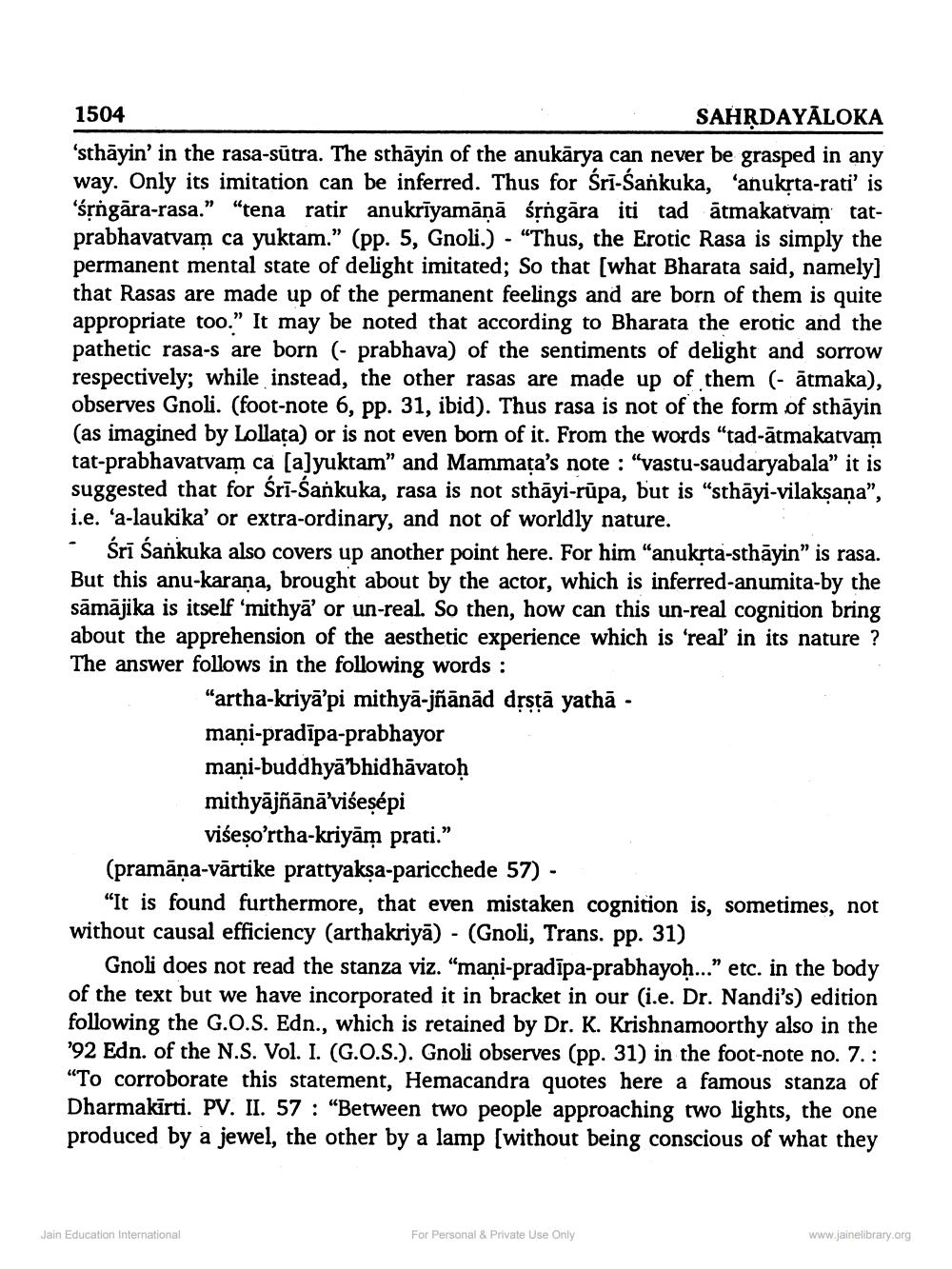________________
1504
SAHṚDAYALOKA
'sthayin' in the rasa-sutra. The sthāyin of the anukārya can never be grasped in any way. Only its imitation can be inferred. Thus for Śrī-Śankuka, 'anukṛta-rati' is śṛngāra-rasa." "tena ratir anukrīyamāṇā śṛngāra iti tad atmakatvam tatprabhavatvam ca yuktam." (pp. 5, Gnoli.) - "Thus, the Erotic Rasa is simply the permanent mental state of delight imitated; So that [what Bharata said, namely] that Rasas are made up of the permanent feelings and are born of them is quite appropriate too." It may be noted that according to Bharata the erotic and the pathetic rasa-s are born (- prabhava) of the sentiments of delight and sorrow respectively; while instead, the other rasas are made up of them (- atmaka), observes Gnoli. (foot-note 6, pp. 31, ibid). Thus rasa is not of the form of sthāyin (as imagined by Lollata) or is not even born of it. From the words "tad-atmakatvam tat-prabhavatvam ca [a]yuktam" and Mammata's note: "vastu-saudaryabala" it is suggested that for Śrī-Śankuka, rasa is not sthāyi-rūpa, but is "sthāyi-vilakṣaṇa", i.e. 'a-laukika' or extra-ordinary, and not of worldly nature.
Śrī Śankuka also covers up another point here. For him "anukṛta-sthāyin" is rasa. But this anu-karana, brought about by the actor, which is inferred-anumita-by the sāmājika is itself 'mithya' or un-real. So then, how can this un-real cognition bring about the apprehension of the aesthetic experience which is 'real' in its nature ? The answer follows in the following words :
"artha-kriya'pi mithyā-jñānād dṛṣṭā yathā -
mani-pradīpa-prabhayor
mani-buddhyā'bhidhāvatoḥ mithyājñānā viseṣépi
viseṣo'rtha-kriyām prati."
(pramāṇa-vārtike prattyakṣa-paricchede 57) -
"It is found furthermore, that even mistaken cognition is, sometimes, not without causal efficiency (arthakriyā) - (Gnoli, Trans. pp. 31)
Gnoli does not read the stanza viz. "mani-pradīpa-prabhayoḥ..." etc. in the body of the text but we have incorporated it in bracket in our (i.e. Dr. Nandi's) edition following the G.O.S. Edn., which is retained by Dr. K. Krishnamoorthy also in the '92 Edn. of the N.S. Vol. I. (G.O.S.). Gnoli observes (pp. 31) in the foot-note no. 7. : "To corroborate this statement, Hemacandra quotes here a famous stanza of Dharmakirti. PV. II. 57: "Between two people approaching two lights, the one produced by a jewel, the other by a lamp [without being conscious of what they
Jain Education International
For Personal & Private Use Only
www.jainelibrary.org




